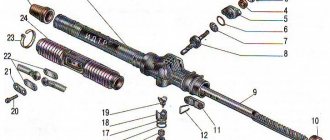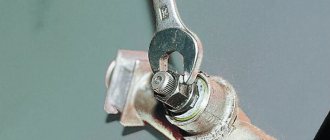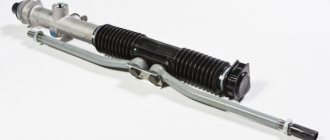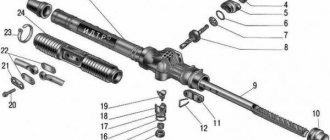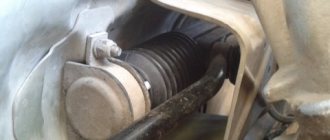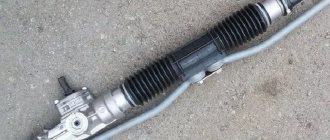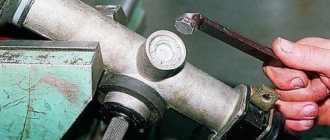The steering rack is a mechanism that connects the steering wheel with rods and levers to the front wheels of the car. Depending on the intensity of use, this system will wear out sooner or later. And most often sooner than we would like. This directly affects the deterioration of the car's handling.
Any motorist should recognize the signs of a faulty steering rack, since the safety of the driver and passengers depends on it. Under such circumstances, it is necessary to immediately replace the broken part or assembly.
Types and design of steering racks
The design of the mechanism is constantly being improved - previously it was a primitive device, but now it contains many different technologies. Now there are 3 types of steering racks.
Regular
There are no amplifiers used here, and the driver takes on all the effort for turning. This rack is no longer installed on modern cars. She is “indestructible”, but turning the steering wheel with her is much harder. The only problem that may arise when using it is knocking, but it can easily be solved by tightening it. The design is reliable and durable, but maneuverability suffers when using it. In addition, it is morally outdated.
The “bare” rack is enclosed in a metal case, inside of which there is a shaft with a gear. Rods with steering tips are connected to it. This entire structure is protected by anther. A shaft connected to the steering wheel engages with the main shaft using a worm tip.
Design with power steering
The design of this mechanism is similar to the previous one, but here the driver puts less effort into turning thanks to the following elements of the system:
- vane pump that pressurizes;
- a piston mounted on a shaft;
- a distributor that monitors the supply of working fluid.
Immediately after turning the steering wheel, the distributor begins to regulate the oil pressure on the spool and torsion bar, supplying it to the piston system from the side required in each specific case. For example, if there was a turn to the right, oil is supplied to the right, and vice versa.
The hydraulic booster is useful from a safety point of view, because it absorbs the impact if the wheel hits a pothole. This is both a plus and a minus, since in this case the control sensitivity decreases. If a leak forms, driving will become doubly difficult. The belt drive used here takes power away from the motor. And yet, a properly functioning hydraulic assistant significantly increases maneuverability and makes the steering light.
Device with EUR
Today this is the most advanced model. Hydraulics here have given way to electric power steering. Here, the signal from the sensors installed on the steering wheel is transmitted to the ECU, and from there to the electric booster. The only weak link here is the capricious electronics, the breakdown of which can be a serious problem.
There are no pumps or pistons, but only the main and steering shafts, connected to each other by a worm gear. On the steering shaft there is a gear rotated by an electric motor. The system includes sensors located on the steering wheel - they tell the ECU the degree of steering wheel deflection during a turn. Then the electronics send a signal to the amplifier, and the steering wheel begins to rotate much more easily.
The system is compact and practically does not take away power from the engine. It works in different modes: rough terrain, highway, city. Disadvantages: fear of moisture and load on the generator.
Characteristic signs of problems
The steering system usually functions reliably and lasts a long time. However, like any other vehicle component, the steering rack and related parts are subject to natural wear and tear. Sooner or later, malfunctions occur in the steering. This process is accelerated by harsh driving style, operation on bad roads, as well as inappropriate storage conditions, for example, in a damp room or in the open air, where there is a high probability of corrosion. Service life can also be reduced by initially poor build quality or the use of defective parts.
Certain symptoms can warn in advance of a possible breakdown. What you should be wary of:
If you have at least one of the listed symptoms, you should immediately repair the steering system. Don't wait until your expensive steering rack completely fails. If you react in time, then perhaps everything will cost you by replacing several cheap parts from the repair kit, which usually includes bearings, bushings, oil seals, and O-rings. Such repairs can be carried out independently, but an inspection hole or lift will be required.
Causes and symptoms of steering rack malfunction
Signs of a faulty steering rack can be obvious or hidden. The first ones are easy to determine - this is done by eye. The second case is more complicated, and here diagnostics need to be carried out only at a service station.
The most pronounced symptom is a knocking noise under the hood that appears when driving over uneven surfaces. It is especially pronounced during a turn. You can also diagnose a malfunction of the rack and pinion mechanism if the steering wheel begins to vibrate while driving over bumps. There are also the following signs of malfunction:
- After turning, the steering wheel hardly returns to its previous position or even refuses to do so.
- The free play of the steering wheel becomes larger, which requires additional adjustments of movement on the part of the driver.
- Extraneous sounds appear while driving.
- The steering wheel turns with effort.
- Oil traces on the unit body.
- And finally, the mechanism may simply jam and the steering wheel will start to rotate randomly.
The reasons for such malfunctions can be different - this includes driving on “dead” roads and driving style. The main enemy of the steering rack is shaking. Dust contamination also plays a negative role here. To avoid having to frequently repair the system, it is better to slow down on uneven roads and do not need to cross tram rails. You will add to your problems if you leave your car in the parking lot with the wheels turned, and in winter you leave it with a cold engine.
Typical faults and methods for their elimination
The steering wheel turns hard
In normal condition, when the engine is running, the steering wheel can be easily rotated with one finger. If you have to apply noticeable force to rotate it, then there is a problem with the power steering or the power steering pump has failed. There is a possibility of hydraulic fluid leaking and air entering the hydraulic system. It is also necessary to check the integrity and tension of the pump drive belt.
In addition, a “heavy” steering wheel may be the result of improper operation of the spool or ring wear inside the distributor.
Annular wear occurs as a result of friction of the Teflon rings of the spool coil against the inner wall of the distributor housing. At the same time, grooves gradually appear on the wall. Due to the loose fit of the rings to the walls, the oil pressure in the system drops, which leads to a heavier steering wheel. The damage can be eliminated by boring the inner wall and pressing in a bronze sleeve that fits the dimensions of the spool mechanism.
It is impossible to prevent ring wear, but if you keep the fluid clean, periodically change it and flush the hydraulic system, you can significantly extend the life of this unit. The fact is that production is greatly facilitated by the presence of metal shavings, which appear in the oil as a result of friction of interacting parts.
Accurate diagnosis and repair of the power steering requires disassembling the steering rack, so if you suspect that the power steering is broken, you should contact a car service center. Moreover, it is better to look for experienced craftsmen.
Knock
When driving even on a not very rough road or on some types of road surface (crushed stone, cobblestones), as well as when crossing rails, a knocking sound is clearly heard in the front of the car on the left, right or center. In this case, play in the steering wheel and vibration in the steering wheel can often be observed.
Such a symptom should never be ignored. And it's not a matter of discomfort at all. If it knocks, it means something has become loose or worn out somewhere. Ignoring it will only make the situation worse and could ultimately lead to complete steering failure. Therefore, you should not hesitate to identify and eliminate such a malfunction.
The knocking noise may occur due to broken rack support bushings, tie rod bushings or steering shaft bushings. The knocking noise may be caused by a loose joint of the tip or rod. The bearing at the bottom of the distributor on which the steering shaft rotates may also be broken. If you remove the rail completely, it will most likely not be difficult to identify the faulty element. Worn elements must be replaced.
Another possible cause of knocking is a gap between the worm and the rack, which appears as a result of wear. You can try to tighten it, but in case of serious wear, the adjustment will not give the desired result, and then the steering rack will have to be replaced.
Knocking and sticking of the steering wheel is also possible due to deformation of the steering rack as a result of an impact. In this case, it must be replaced.
It should be remembered that some suspension parts, in particular shock absorber struts, can produce a similar knocking noise. Therefore, if everything is in order with the steering system, but there is a knock, check the chassis.
Rumble and rattle
The hum occurs due to the power steering pump, which is on its last legs and requires replacement. Or the pump drive belt tension has weakened. In addition, you need to check for fluid leaks. This symptom is often accompanied by a “heavy” steering wheel.
In a system with an electric steering rack, a worn ESD motor may hum.
If you hear a grinding noise while turning the steering wheel, this is a sign of corrosion of the steering shaft or bearing in the distributor. In this case, the bearing must be replaced; the steering shaft can be sanded if there is little rust. If corrosion has severely damaged the distributor, it will have to be replaced.
Working fluid is quickly consumed
If you constantly have to add fluid to the hydraulic system reservoir, it means there is a leak somewhere. It is necessary to check the integrity of the hoses, identify and replace worn oil seals and seals in the rack, pump and distributor. Wear of oil seals and O-rings occurs naturally due to friction of moving parts and exposure to pressure and heat. The process of their wear is noticeably accelerated by rust on the rack parts, which can appear as a result of moisture entering through a torn boot.
Steering wheel sticking
This malfunction can be caused by various reasons. To identify it, a comprehensive troubleshooting of the steering control in a car service is required. It is possible that the situation has reached a critical level, so repairs should be made as soon as possible.
Boot damage
To determine the condition of the anthers, you will have to look under the bottom of the car. The boot is not a small thing at all. Even a small crack can lead to loss of lubrication and the entry of dirt and water into the hinge joint. As a result, after some time it will be necessary to replace the rod or even the entire steering rack, since moisture can penetrate into the rack body and cause corrosion of internal parts. It is easier and much cheaper to replace a torn boot in time.
Ignoring the symptoms of a malfunction will sooner or later lead to the final breakdown of the steering rack and significant financial expenses. The worst-case scenario is that the steering wheel gets stuck. If this happens at high speed, it can lead to an accident with serious consequences.
Following some simple rules will help to extend the life of the steering rack:
- do not leave the steering wheel in the extreme position for more than 5 seconds;
- slow down if you have to drive on a bad road or overcome speed bumps, rails and other obstacles;
- monitor the level of working fluid in the power steering reservoir;
- In winter, before starting to drive, gently turn the steering wheel in both directions a couple of times, this will allow the fluid in the power steering to warm up;
- Regularly monitor the condition of the anthers.
Consequences of a faulty steering rack
If the first symptoms of a malfunction appear, it is better not to take risks and stop using the car. The purpose of the steering rack is to simplify the control of the car, and this function is directly related to safety. The consequences of a malfunction of this mechanism can be very serious, including complete loss of controllability. Therefore, it is better to repair the steering rack at the stage when it just begins to creak and show other initial signs of failure.
Popular brands:
Kia Sportage
Advantages and disadvantages
The steering racks of today's cars are most often equipped with amplifiers: hydraulic or electric. But this does not completely deprive them of all the “cons”. But first, about the “pluses”.
Main advantages:
- Simple design and small dimensions and weight.
- Easy to maintain.
- Good obedience when driving.
Flaws:
- It transmits impacts from uneven road surfaces to the steering wheel, although devices with power steering soften these impacts.
- During production, backlashes appear, creating knocking and noise.
Repair or install a new one
It is difficult to answer this question unambiguously; an integrated approach is needed here. Of course, it would be safer to replace the part with an original one, but this is a rather expensive option. Therefore, many drivers buy contract racks - these are used units that were removed from scrapped cars.
Basically, car enthusiasts limit themselves to purchasing a repair kit. There is one subtlety here - you need to buy only a high-quality, and therefore not cheap, set. Savings are inappropriate here.
There are also other questions: how to determine if the steering rack is faulty so as not to make a mistake, and who will repair it? Still, it is better to entrust this work to a master and, preferably, an experienced one. You can get by with little expense if you purchase a high-quality kit and entrust its installation to a professional - this is a worthy alternative to completely replacing the unit. It is important to ensure that you are provided with a guarantee for the result of the work.
If the car has an electronically controlled rack, then in terms of repair this is a difficult case. Service workers recommend changing the part regardless of the complexity of the work. Electronic malfunctions are costly in terms of money and time, in addition, they require extensive technical skills from the performers.
If the gears in the transmission unit are at an early stage of wear, then the resulting play can be eliminated by adjusting the screws. It’s better not to do this work yourself - if you overdo it a little, you can completely eliminate the gaps, which will only accelerate the wear of the gear train.
Reasons for failure
If there are knocks and squeaks in the steering rack, then there may be the following explanations:
- the shaft has already worn out inside the bushing;
- critical wear of the distributor worm pair has occurred;
- the toothed part of the shaft has worn off;
- The tie rod ends are worn out.
Due to corrosion, moisture and sand entering through the bushing seals, an abrasive surface is formed between the rubbing surfaces, which destroys the shaft, plastic or bronze bushing. To fix the problem, you need to replace the worn part and use a special repair kit.
Problems with the steering wheel after repair. What to do
How to identify a malfunction if, after repair, the steering wheel becomes difficult to control? Most likely the shaft nut was overtightened. Service workers, as a rule, recommend waiting a few days, explaining that the mechanisms have not yet had time to get used to it. Reasons why the steering wheel may be difficult to rotate after rack repair:
- overtightened nut;
- air has entered the booster hydraulics;
- low-quality oil was poured into the system;
- The hydraulic booster pump began to malfunction.
If the nut is overtightened, the problem can be easily solved by loosening the stop element. The “air” issue is solved by pushing bubbles out of the system. To do this, you need to turn the steering wheel several times from one extreme position to another. If the problem persists, you need to look for the leak point. We drain and replace non-original oil, but an incorrectly functioning power steering pump will have to be returned to specialists for modification.
What's the result?
Taking into account the information provided, it becomes clear that the steering rack is the most important element in the steering control of many cars. Comfort and safety depend on the quality and efficiency of the slats. However, many steering racks are equipped with a power steering, which means the need for periodic checks and regular maintenance (especially in the case of power steering).
We also recommend reading the article on how to change the power steering oil yourself. From this article you will learn what kind of oil to pour into the power steering, what needs to be taken into account when selecting power steering oil, as well as how to change the oil in the power steering and what features you should pay attention to as part of this procedure.
Finally, we note that there should be no failures in the operation of the steering; any deviations from the norm are unacceptable and are the basis for professional diagnostics, repair or replacement of a damaged or worn-out unit. At the same time, timely measures taken taking into account the signs of problems discussed above often make it possible to avoid expensive restoration of the steering rack, replacement of the steering rack with a new one, etc.
The main thing is that all repair and maintenance work is carried out by experienced specialists. Otherwise, malfunctions and steering failures cannot be ruled out, which can lead to serious accidents and other consequences.
Recommendations for extending service life
- Google+
- LJ
- Blogger
Remember that prevention is the best way to prevent problems. To extend the life of this mechanism, simple rules should be followed:
- Check the boots regularly. If they develop a crack or hole, it is better to replace them immediately.
- In winter, you first need to warm up the engine and only then start driving and turn the steering wheel. It is best to lightly turn the steering wheel from side to side in place to warm up the oil.
- Slow down in front of potholes and bumps and try to go around them.
- Don't forget to change the power steering fluid.
- You should not move away abruptly, especially if the steering wheel is turned all the way.
A steering rack is a mechanical device for transmitting force from the steering mechanism to the wheels. The steering rack structure looks complicated on the outside, but few craftsmen understand the internal mechanisms and know how to repair them. Therefore, if malfunctions occur, you should find a good car service to troubleshoot steering systems or change the entire mechanism.
Repairing steering racks is a complex process that a novice car enthusiast cannot handle.
